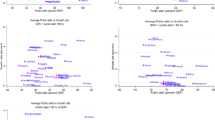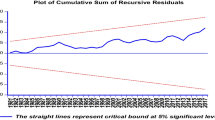Abstract
In this paper we investigate whether exchange rate pass-through (ERPT) responds nonlinearly to economic activity along the business cycle. Using quarterly data spanning the period 1975:1 to 2011:1, we explore the existence of nonlinearities in ERPT to CPI inflation for the Finnish economy. Within a logistic smooth transition framework, our investigations reveal a strong regime-dependence of pass-through, depending positively on economic activity. Besides, point estimates indicate that the long-run pass-through coefficient is equal to 0.15 % (weakly significant) when GDP growth is below a threshold of 3 %. However, when the Finnish economy’s growth rate speeds up—above the threshold of 3 %—ERPT elasticity increases to 0.47 %. These results provide some useful guidance on how policymakers should act over different phases of the business cycle. More specifically, monetary policy should factor in the nonlinear mechanism of ERPT over the business cycle in order to prevent exchange rate movements from fueling a continuous inflationary process.



Similar content being viewed by others
Notes
Econlit and Business Source Complete databases together yield more than 1800 entries for the terms “exchange rate pass-through”.
See Ben Cheikh and Rault (2015) for a recent literature review on the ERPT.
According to Ketelsen and Kortelainen (1996), the evolution from fixed to floating entailed a structural change in the Finnish pass-through elasticities.
The structure of the economy changed fundamentally. The old forestry and engineering industries became less important while high-tech sectors such as the mobile phone industry dominated the recovery process (see Jonung and Hagberg 2005).
More details about the transition variable are given in “Empirical results”.
Individual series in level are non-stationary according to the efficient unit-root test suggested by Elliott et al. (1996), and the Kwiatkovski-Phillips-Schmidt-Shin (Kwiatkowski et al. 1992) test, extended by Carrion-i-Silvestre and Sanso (2006). We also tested for the presence of a cointegrating relationship between variables (in levels) entering the pass-through equation using the well-known cointegration tests of Johansen (1988, 1991), and we report that variables are not cointegrated. Results are available upon request. Consequently, log differences of the variables are used in the estimation of the logistic STR pass-through equation given in Eq. (1).
The power of employees in wage negotiations is also more important during recovery periods resulting in a higher propensity of producers to price increases.
According to van Dijk et al. (2002) estimates of \(\gamma \) may appear to be insignificant. This should not be interpreted as evidence of weak nonlinearity.
Furthermore, the study of Campa and Goldberg (2005) is conducted over the period 1975–2003, which contains a longer period prior to the EMU era but fewer observations in the post-Eurozone period. In our study, we propose an update to ERPT elasticities for Finland using a longer time period and more observations for the post-Eurozone era. Finally, Campa and Goldberg (2005) assumed a linear connection between pass-through and macroeconomic factors (such as inflation environment, money growth or country size) rather than testing it. In our paper, we explicitly test for linearity, namely with respect business cycle, and provide estimates of ERPT along different phases of the business cycle.
References
Bailliu, J., and E. Fujii. 2004. Exchange rate pass-through and the inflation environment in industrialized countries: an empirical investigation, Working Paper No. 2004–21, Bank of Canada.
Ben Cheikh, N. 2012. Non-Linearities in Exchange rate pass-through: evidence from smooth transition models. Economics Bulletin 32(3): 2530–2545.
Ben Cheikh, N., and C. Rault. 2015. Recent estimates of exchange rate pass-through to import prices in the euro Area. Review of World Economics. doi:10.1007/s10290-015-0233-x.
Campa, J., and L. Goldberg. 2005. Exchange rate pass-through into import prices. The Review of Economics and Statistics 87(4): 679–690.
Carrion-i-Silvestre, J., and A. Sanso. 2006. A guide to the computation of stationarity tests. Empirical Economics 31: 433–448.
Correa, A. and A. Minella. 2006. Nonlinear mechanisms of exchange rate pass-through: a phillips curve model with threshold for Brazil. Working Paper No. 122, Central Bank of Brazil.
Elliott, G., T. Rothemberg, and J. Stock. 1996. Efficient tests for an autoregressive unit root. Econometrica 64: 813–839.
García, C. J. and J. E. Restrepo. 2001. Price inflation and exchange rate pass-through in Chile. Working Paper No. 128, Central Bank of Chile.
Goldberg, P.K., and M. Knetter. 1997. Goods prices and exchange rates: what have we learned? Journal of Economic Literature 35(3): 1243–1272.
Goldfajn, I., and S.R.C. Werlang. 2000. The pass-through from depreciation to inflation: a panel study. Working Paper No. 423, Banco Central Do Brasil.
Johansen, S. 1988. Statistical analysis of cointegration vectors. Journal of Economic Dynamics and Control 12(2–3): 231–254.
Johansen, S. 1991. Estimation and hypothesis testing of cointegration vectors in gaussian vector autoregressive models. Econometrica 59(6): 1551–1580.
Jonung, L., and T. Hagberg. 2005. How costly was the crisis of the 1990s? A comparative analysis of the deepest crises in Finland and Sweden over the last 130 years. Economic Paper No 224, European Commission.
Jonung, L., J. Kiander, and P. Vartia. 2008. The great crisis in Finland and Sweden: the macrodynamics of boom, bust and recovery 1985–2000. Economic Paper No 350, European Commission.
Ketelsen, U., and M. Kortelainen. 1996. The pass-through of exchange rate changes to import prices. Discussion Papers 26/96, Bank of Finland.
Kwiatkowski, D., P. Phillips, P. Schmidt, and Y. Shin. 1992. Testing the null hypothesis of stationarity against the alternative of a unit root: how sure are we that economic time series have a unit root? Journal of Econometrics 54(1–3): 159–178.
Nogueira Jr., R. P. and M. Leon-Ledesma (2008), Exchange rate pass-through into inflation: the role of asymmetries and nonlinearities. Studies in economics no. 0801. Department of Economics, University Of Kent.
Nogueira Jr, R.P., and M. Leon-Ledesma. 2011. Does exchange rate pass-through respond to mesures of macroecomic instabiltity? Journal of Applied Economics XIV(1): 167–180.
Shintani, M., A. Terada-Hagiwara, and Y. Tomoyoshi. 2013. Exchange rate pass-through and inflation: a nonlinear time series analysis. Journal of International Money and Finance 32: 512–527.
Teräsvirta, T. 1994. Specification, estimation and evaluation of smooth transition autoregressive models. Journal of the American Statistical Association 89: 208–218.
Teräsvirta, T. 1998. Modelling economic relationship with smooth transition regressions. In Handbook of applied economic statistics, ed. D.E.A. Giles, and A. Ullah. New York: Marcel Dekker.
van Dijk, D., T. Teräsvirta, and P. Franses. 2002. Smooth transition autoregressive models: a survey of recent developments. Econometric Reviews 21: 1–47.
Author information
Authors and Affiliations
Corresponding author
Rights and permissions
About this article
Cite this article
Ben Cheikh, N., Rault, C. The Role of the Business Cycle in Exchange Rate Pass-Through: The Case of Finland. J. Quant. Econ. 14, 15–27 (2016). https://doi.org/10.1007/s40953-015-0025-0
Published:
Issue Date:
DOI: https://doi.org/10.1007/s40953-015-0025-0




